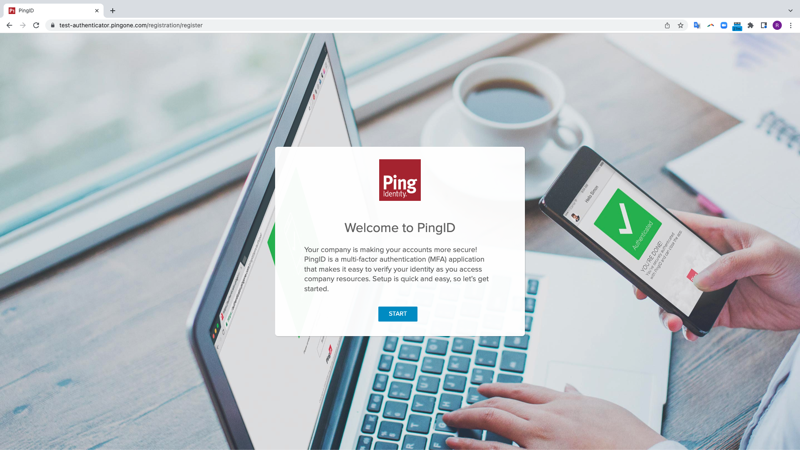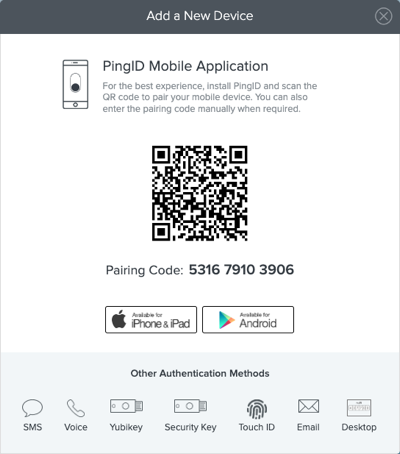Using SMS or voice authentication with PingID
You need to register or 'pair' your mobile device with your account so that you can receive a one-time passcode (OTP) to your device by SMS or voice call, and use it to authenticate securely with PingID.
Pairing a device creates a trust between your device and your account so that you can use your device to authenticate during the sign-on process. After you have paired your device, each time you sign on to your account or application, you receive a one-time passcode (OTP) through SMS or voice call with which to authenticate.
You can use SMS or voice calls to access your account using a Web browser, to access your company’s VPN, or to access a Windows login or Mac login machine.
|
The option to pair your account with this device type is defined by your company policy. |
-
Web or Mac
-
VPN
-
Windows login
Pairing your mobile device for SMS or voice authentication with PingID
Register or 'pair' your mobile device so that you can receive a one-time passcode (OTP) by SMS or voice call and use it to authenticate securely with PingID.
About this task
|
After you have paired your device, and authenticated successfully, you can also use it to authenticate for Windows login or Mac login, if required. |
Steps
-
Sign on to your account or app and when you see the registration window, click Start.

You’ll see the Add a New Device window, showing the SMS and Voice icons.

-
In the Add a New Device window, click either SMS or Voice.
-
In the SMS window, in the international country code list, select your international country code and enter your phone number you want to use to authenticate. Click Next.

To support voice calls using phone numbers with extensions, enter the phone number followed by a comma and the extension number. Examples include:
-
The phone number +12025550123 with the extension 2992 is entered as +12025550123,2992.
-
The extension can include the # or * characters. For example: +12025550123,#2992 or +12025550123,2992#.
-
If there is more than one extension, then a comma should separate the extension and the nested extension. For example: +12025550123,#2992,#2991.
-
Each comma generates a 2-second pause. After the call is answered, the extension is dialed after two seconds. If a pause is required for longer than 2 seconds, add an additional comma for each additional 2-second pause. For example, three commas for a 6-second pause before the nested extension: +12025550123,#2992,,,#2991.
Result:
PingID sends a one-time passcode (OTP) to your mobile through SMS or voice call.

-
-
In the Authentication window, enter the OTP. Click Verify.
Result:
When successfully verified, the green Authenticated message appears, and you are automatically signed on to your account or app.
Next steps
The next time you sign on to your organization dock or application:
-
PingID sends an OTP to your mobile device.
-
In the Authentication window, enter the OTP.
-
Click Sign On to complete the authentication.
For information, see Authenticating with PingID using SMS or voice.
Pairing your mobile device for SMS or voice authentication (VPN)
Register or 'pair' your mobile device so that you can receive a one-time passcode (OTP) by SMS or voice call and use it to access your company’s VPN securely with PingID. Pairing a device creates trust between your device and your account so that you can use your device to authenticate during the sign-on process.
About this task
To set up SMS or voice authentication for your VPN:
Steps
-
From your web browser or application, sign on to your VPN with your username and password.
-
Enter
other. Click Sign In. -
In the text entry field, enter the phone number that you want to use to authenticate:
Choose from:
-
For SMS: Enter
smsfollowed by the country code and your mobile number in the format sms:1-4155555555. Click Sign In. -
For voice: Enter
voicefollowed by the country code and your mobile number in the format voice:1-4155555555. Click Sign In.Phone numbers with extensions are supported for voice calls where the phone number is followed by a comma and the extension number. Examples include:
-
The phone number +12025550123 with the extension 2992 is entered as +12025550123,2992.
-
The extension can include the # or * characters. For example: +12025550123, #2992 or +12025550123,2992#.
-
If there is more than one extension, a comma should separate the extension and the nested extension. For example: +12025550123,#2992,#2991.
-
Each comma generates a 2-second pause. After the call is answered, the extension is dialed after 2 seconds. If a pause is required for longer than 2 seconds, add an additional comma for each additional 2-second pause. For example, three commas for a 6-second pause before the nested extension: +12025550123,#2992,,,#2991.
Result:
-
You receive a one-time passcode (OTP) to your device through either SMS or voice call.
-
-
In the text entry field, enter the OTP from step 3 and then click Sign In.
Result:
Your device is paired and authentication complete.
Next steps
The next time you sign on to your VPN, an OTP is sent to your device and in the VPN entry field, you’ll be asked to enter the OTP to authenticate. For information, see Authenticating with PingID using SMS or voice.
Pairing your mobile device for SMS or voice authentication (Windows login)
Register or 'pair' your mobile device so that you can receive a one-time passcode (OTP) by SMS or voice call and use it to access your Windows login machine securely with PingID.
Steps
-
Sign on to your Windows machine.

Result:
The PingID registration window displays.

Until you successfully complete the registration process, you cannot minimize the PingID registration window. If you close the window, you are automatically redirected back to the Windows login page.
-
Click I want to use a different authentication method.
-
In the Alternative Authentication window:
-
Enter your authentication preference, select either Receive passcodes via SMS or Receive passcodes via voice call.
-
From the country code list, select the country code.
-
Enter the phone number that you want to use to authenticate.
-
Click Next.
Phone numbers with extensions are supported for voice calls when the phone number is followed by a comma and the extension number. Examples include:
-
The phone number +12025550123 with the extension 2992 is entered as +12025550123,2992.
-
The extension can include the # or * characters. For example: +12025550123,#2992 or +12025550123,2992#.
-
If there is more than one extension, then a comma should separate the extension and the nested extension. For example: +12025550123,#2992,#2991.
-
Each comma generates a 2-second pause. After the call is answered, the extension is dialed after 2 seconds. If a pause is required for longer than 2 seconds, add an additional comma for each additional two-second pause. For example, three commas for a 6-second pause before the nested extension: +12025550123,#2992,,,#2991.

Result:
-
A one-time passcode (OTP) is sent to your mobile through a SMS or voice call.
-
-
In the Authentication window, enter the passcode into passcode field. Click Verify.
-
The next time you sign on to your Windows machine or application:
-
An OTP sends to your mobile prompting you to enter it in your browser.
-
Enter the passcode in the Authentication window in your browser.
-
Click Sign On to complete the authentication.
-
Result
The green Authenticated message appears with a check mark, indicating authentication is successful. You are signed on to your Windows machine.

Next steps
Next time you sign on to your Windows machine, you’ll be able to authenticate using the OTP sent to your mobile device using SMS or Voice. For information, see Authenticating with PingID using SMS or voice.